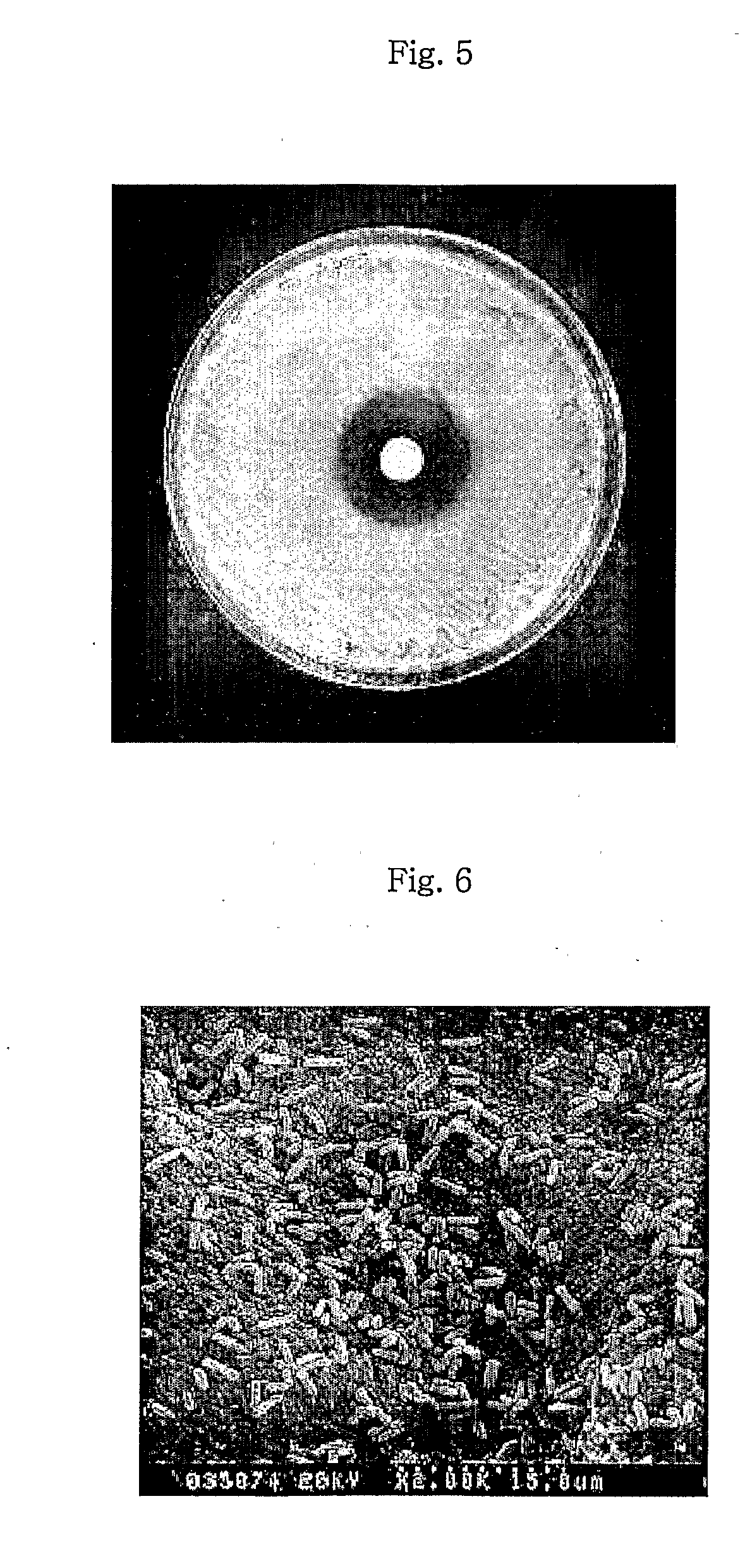Novel Acid Tolerant Lactobacillus Sakei Probio-65 with the Ability of Growth Suppression of Pathogenic Microorganisms and the Anti-Allergic Effect
a technology of lactobacillus sakei and probiobacterium, which is applied in the field of new lactobacillus sakei probio65, can solve the problems of reducing the ability to adapt to new environments, affecting the normal development of personal relationships and social activities, so as to inhibit harmful microorganisms, inhibit the proliferation of staphylococcus aureus, and inhibit the growth of a broad spectrum
- Summary
- Abstract
- Description
- Claims
- Application Information
AI Technical Summary
Benefits of technology
Problems solved by technology
Method used
Image
Examples
example 1
Isolation of Lactobacillus sp. Strains
[0061]Home-made Kimchi juice (fermented) was diluted, smeared onto BCP solid medium (Eiken Chemical, Japan), and cultured at 37° C. for 48 hrs. After emerged colonies were microscopically observed, a total of 480 micrococci and bacilli were selected, cultured in MRS medium (Difco), and stored at −80° C. Finally, a microorganism inhibiting the proliferation of Staphylococcus aureus KCTC1621, which is a factor aggravating atopic diseases, was selected and designated Lactobacillus sakei Probio-65 (FIG. 6).
example 2
Identification of the Isolated Lactobacillus sakei Probio-65 Strain
[0062]The Probio-65 strain isolated in Example 1 was cultured in MRS medium (Difco) at 37° C. In order to identify the Probio-65 strain, the morphological and physiological characteristics of the Probio-65 strain were determined using a method described in the literature: Yoon et al., Int. J. Syst. Bacteriol., 47, 904, 1997 using API 32A and API CHL systems (BioMerieux). The nucleotide sequence of 16S rDNA gene was determined and analyzed using a method described in Yoon et al., Int. J. Syst. Bacteriol., 47, 933, 1997.
[0063]The Probio-65 strain was found to be a Gram-positive bacterium. The bacterial strain grew under both aerobic and anaerobic conditions, did not form spores, was non-motile, and was a bacillus type. The optimal temperature for the growth of the strain ranged from 30° C. to 37° C. The Probio-65 strain did not generate gas and indole, did not display lytic properties, and did not reduce nitric acid. A...
example 3
Evaluation of the Inhibitory Effects of the Isolated Microorganism on Harmful Microorganisms
[0064]The primarily isolated microorganisms were evaluated for growth inhibitory activity versus harmful pathogenic microorganisms using a method described by Kuroiwa et al. (Kuroiwa et al., Journal of Infections, 64, 257, 1990). In this antibiotic activity evaluation, ten microbial strains were used: E. coli KCTC 2441, Klebsiella pneumoniae KCTC 2208, Staphylococcus aureus KCTC 1621, Staphylococcus epidermidis KCTC 1917, Shigella flexneri KCTC 2008, Salmonella gallinarum, Enterobacter cloacea KCTC 2361, Salmonella typhimurium, Citrobacter freundii KCTC 2006, and Methylosinus trichosporium KCTC 2591.
[0065]The harmful pathogenic microorganisms were individually cultured in nutrient broth (NB) at 37° C. for 18 hrs. 0.1 ml of each culture fluid was smeared onto nutrient agar (NA) plates and air-dried, and a cylinder 8 mm in diameter was placed onto each plate. Separately, the primarily isolated ...
PUM
| Property | Measurement | Unit |
|---|---|---|
| optimal temperature | aaaaa | aaaaa |
| temperature | aaaaa | aaaaa |
| temperature | aaaaa | aaaaa |
Abstract
Description
Claims
Application Information
 Login to View More
Login to View More - R&D
- Intellectual Property
- Life Sciences
- Materials
- Tech Scout
- Unparalleled Data Quality
- Higher Quality Content
- 60% Fewer Hallucinations
Browse by: Latest US Patents, China's latest patents, Technical Efficacy Thesaurus, Application Domain, Technology Topic, Popular Technical Reports.
© 2025 PatSnap. All rights reserved.Legal|Privacy policy|Modern Slavery Act Transparency Statement|Sitemap|About US| Contact US: help@patsnap.com



